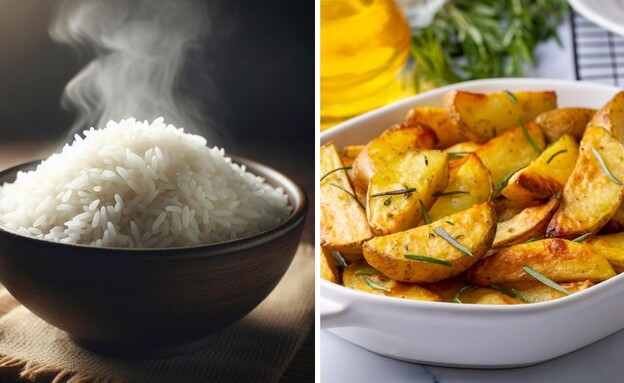Calories and carbohydrates
100 grams of cooked white rice has about 130 calories and 28 grams of carbohydrates. In contrast, 100 grams of boiled potato with skin has only 77 calories and 17 grams of carbohydrates. An average portion of rice (150 grams) will cost you about 195 calories, while an average portion of potato (220 grams) with only 170 calories.
conclusion: A potato provides more volume and fewer calories per serving, making it a better option in terms of calorie consumption.
Effect on blood sugar levels
White rice, with a high glycemic index (87-73) raises blood sugar levels relatively quickly, which may lead to a sharp drop later. A potato can be eaten in two situations: with the skin, the glycemic index is relatively low (65-50) thanks to the fibers that slow down the breakdown of carbohydrates; Without the skin, the glycemic index of a potato is more similar to that of rice. The data refers to eating the supplements only, without the addition of protein or fat.
conclusion: A potato with skin is better for keeping blood sugar levels stable.
nutritional values
In terms of nutritional values, a potato contains 19% of the recommended daily allowance for potassium, 27% of the daily allowance of vitamin C, as well as dietary fiber that helps with proper digestion and prolongs the feeling of satiety. It also contains B vitamins, which are essential for normal metabolism and the health of the nervous system. Even without the skin, a potato still offers nutritional benefits, but the amount of fiber and vitamins is small.
On the other hand, white rice undergoes processing processes that reduce its fiber and mineral content.
conclusion: A potato, especially with skin, is richer in nutritional values than white rice.
Satiety and digestive system health
A potato with skin provides a longer feeling of satiety thanks to its fibers, which slow down the rate of digestion and prolong the feeling of fullness. A potato without the skin is still satisfying, but for a shorter time due to the lack of fiber in the skin. White rice has almost no fiber, so it is digested quickly and provides only a temporary feeling of satiety, which can lead to earlier hunger.
conclusion: A potato is better for creating prolonged satiety and reducing snacking between meals.
In conclusion: Potato turns out to be the healthier choice compared to white rice. It is lower in calories, rich in minerals such as potassium and vitamin C, contributes to a prolonged feeling of satiety thanks to the fiber, and helps maintain the stability of blood sugar levels, especially when eaten with the peel.
The writer is Ziv ZafarNi Clinical and sports dietitian

taylor russell movies and tv shows | Vocal
taylor russell movies | CreativeLive
Renderosity – 3D Models | 3D Software | 3D Art
taylor russell movies and tv s • Facer: the world's largest watch face platform
taylor russell User Profile on BitsDuJour
neil patrick harris amy winehouse cake | Vocal
neil patrick harris amy | CreativeLive
Renderosity – 3D Models | 3D Software | 3D Art
amy winehouse cake • Facer: the world's largest watch face platform
amy winehouse cake Profile on BitsDuJour
pedrovazpaulo executive coaching | Vocal
pedrovazpaulo executive | CreativeLive
Renderosity – 3D Models | 3D Software | 3D Art
pedrovazpaulo executive coachi • Facer: the world's largest watch face platform
pedrovazpaulo User Profile on BitsDuJour
kill tooth pain nerve in 3 seconds permanently | Vocal
kill tooth pain nerve in | CreativeLive
Renderosity – 3D Models | 3D Software | 3D Art
kill tooth pain nerve in 3 sec • Facer: the world's largest watch face platform
kill tooth pain nerve in User Profile on BitsDuJour